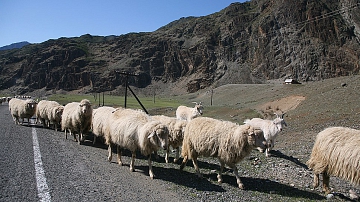ASU scientists conduct paleogenetic research on sheep
 ASU scientists compared genetic data of ancient and modern sheep and found out that ancient Altai sheep, which have already become extinct, were much larger, heavier and more productive than their present-day descendants.
ASU scientists compared genetic data of ancient and modern sheep and found out that ancient Altai sheep, which have already become extinct, were much larger, heavier and more productive than their present-day descendants.
“We have been able to discover the fact that there were several sheep breeds in the south of Western Siberia in the past. Further paleogenetic studies will help us understand when and how they disappeared. Later on there will be a possibility to reproduce ancestors’ outstanding qualities,” Professor of the Department of Archaeology, Ethnography and Museology at Altai State University Alexey A. Tishkin stated with confidence.
Archaeologists and paleogeneticists of Altau State University discovered sheep’s remains in burial mounds of the Bronze Age (2500–2000 BC). The animals were buried there, because they were supposed to accompany their owners in the afterlife. The scientists collected 15 fragments of ancient sheep’s bones and teeth, which helped them identify genetic information and reconstruct mitochondrial DNA (this part of genetic information is only inherited the mother).
Genetic profile of ancient Altai sheep turned out to be amazingly diversified. The scientists believe that during the Bronze Age a lot of people traveled through Altai with their own domestic animals species, so part of their genetic information got stuck here. A.A. Tishkin and his team tried to answer two questions: where did sheep come from to Altai and when did locals stop gathering and come over to cattle breeding.
“We wanted to find out how sheep had appeared here and how they had got spread on the territory of Siberia,” Professor A.A. Tishkin said. “This issue still remains open. Sheep could have appeared in Altai not straight from Iranian Plateau, but from Western Europe together with migrants. In order to answer this question, we will carry out research of animal and human genetics and study all existing archeological evidence.”
For the time being, A.A. Tishkin and his colleagues have discovered that ancient Altai sheep were noticeably larger and heavier that modern ones. The scientists have not figured out why Altai sheep species had disappeared, but dramatic depauperation in genetic diversity of sheep points out the fact that they had come through a catastrophe.